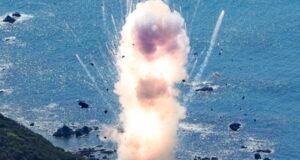
Mascot will then analyse the asteroid’s surface properties, including its mineral composition and magnetic field.
Hayabusa-2 reached the asteroid Ryugu in June this year after a three-and-a-half-year journey.
On 21 September, Jaxa celebrated a first, as its “mothership” deployed two robot explorers to the surface of Ryugu.
Now, it’s the turn of the Mobile Asteroid Surface Scout (Mascot), which has been built by the German Aerospace Center (DLR) and the French Space Agency (Cnes).
Hayabusa-2 spent Tuesday reducing its altitude from its “home position” of 20km above the asteroid. At about 02:00 BST, and at an altitude of about 56m from Ryugu’s surface, Mascot will be commanded to separate from its Japanese “mothership”.
Mascot will then touch down at its pre-selected landing site. Mission planners expect it to bounce before coming to a stop.
“Of course, we have a very low gravitational field there,” said Dr Ralf Jaumann, the principal investigator for Mascot.
“This means the gravity is so low that Mascot more or less flies down, similarly to a piece of paper falling onto a table from a height of 30cm.”
The 9.6kg (21lbs) science package will then begin its investigation of the asteroid surface. Mascot will study Ryugu’s mineral make-up, temperature and magnetic characteristics.
The lander’s payload consists of four science instruments, an infrared microscope called MicrOmega, a camera called MASCAM, a radiometer for measuring the power of electromagnetic radiation (MARA) and a magnetometer to measure magnetic forces (MASMAG).
“The goal is to really understand the asteroid,” said Christian Krause, the operations manager for Mascot.
“Understanding how everything here formed – our Earth and the other planets. This is what we are trying to investigate.”
Ralf Jaumann added: “The question of where the water on Earth originates hasn’t really been answered yet.”
We know that asteroids contain water today. Some scientists think that both asteroids and comets could have delivered water to Earth in the early days of the Solar System, when they collided with our planet.
Hayabusa-2 was launched from the Tanegashima Launch Center in far southern Japan on 3 December 2014. It has been carrying a number of instrument payloads for release on to the surface of its target, Ryugu.
On 21 September, it released two robot rovers onto Ryugu, which quickly returned images and the first video ever sent from the surface of an asteroid.
In late October, the spacecraft will descend to the surface to collect a sample of rock and soil.
Even further on in the mission, Jaxa plans to detonate an explosive charge that will punch a crater in Ryugu.
Hayabusa-2 would then descend into the crater to collect fresh rocks that have not been altered by aeons of exposure to the environment of space.
These samples will then be sent to Earth for laboratory studies.
 Weekly Bangla Mirror | Bangla Mirror, Bangladeshi news in UK, bangla mirror news
Weekly Bangla Mirror | Bangla Mirror, Bangladeshi news in UK, bangla mirror news






